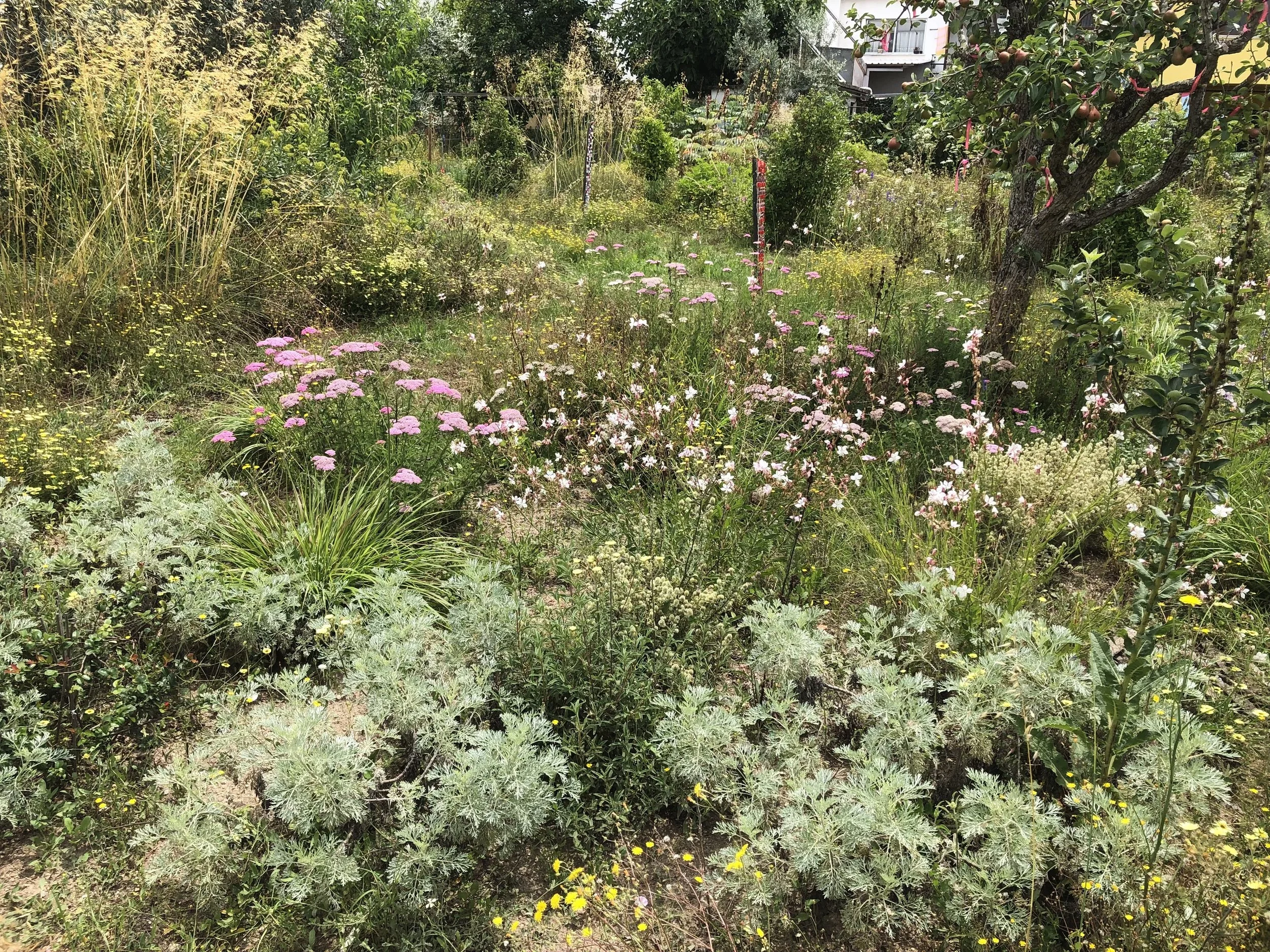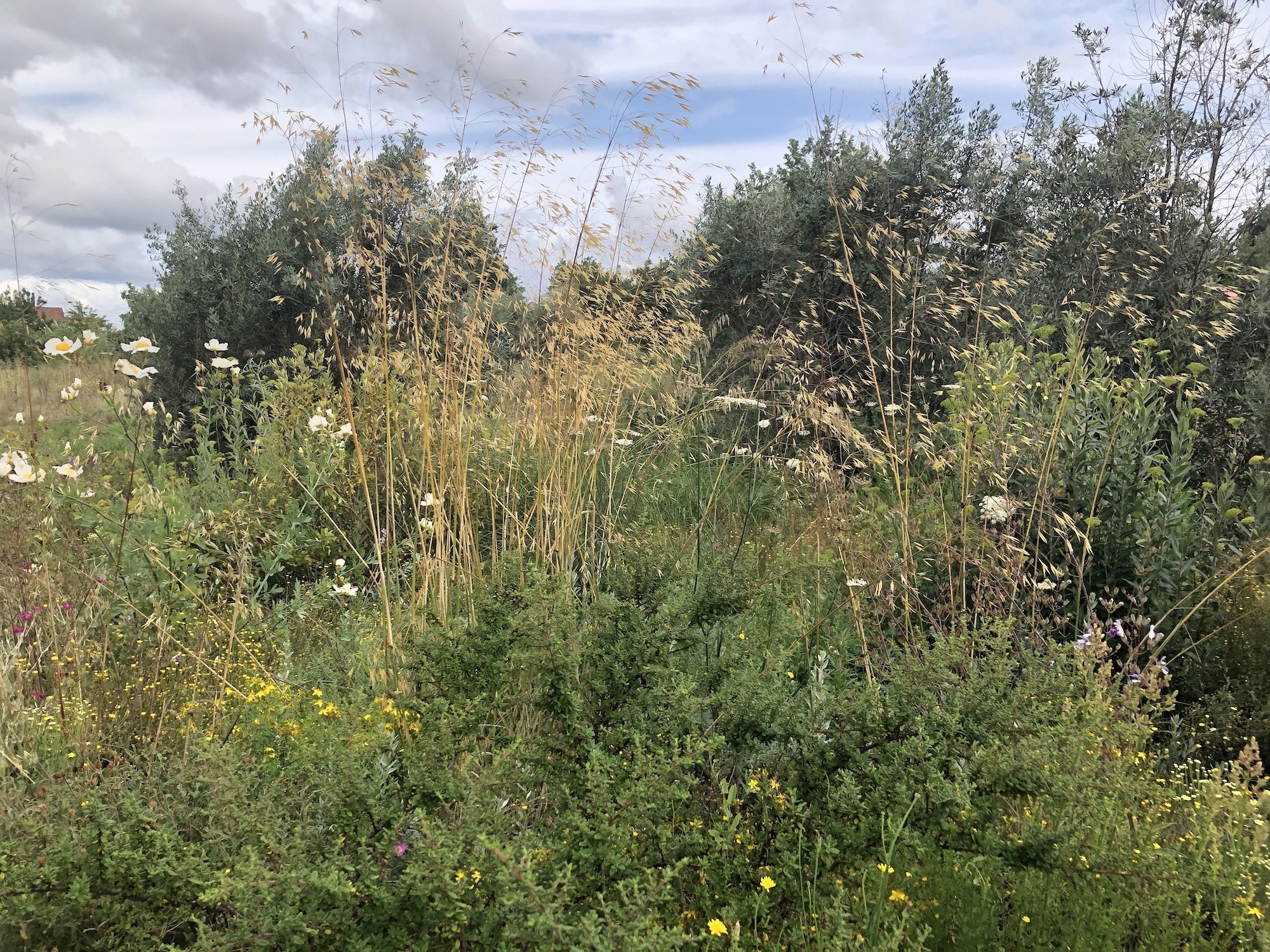Pale yellow Tolpis barbata filling what is normally a path last month. Some Melianthus major flowerheads in the background and Pelargonium quercifolium.
Part of the zeitgeist is that there seems to be a great evaluation of what weeds are at the moment. The RHS (bending over backwards to be in with nature conservation bodies, and be generally politically correct) is even beginning to frown on the word. More on this later perhaps in a later posting (there is a lot of trendy nonsense to be probed) but for now I'd like to look positively at the annuals in my Portuguese garden. Many people would see them as weeds, in that they are spontaneous plants that can spread very rapidly and cause problems to our gardening efforts, but for me they fall into a more ambiguous category. In my last garden (Herefordshire in England) the weeds were legion, overwhelmingly perennial, overwhelmingly very competitive, and rooted into heavy loam – they were a big problem. Here they are legion, but overwhelmingly annuals, and rooted into a very sandy soil – so they are so easy to get rid of - there is no comparison with gardening in Herefordshire! I have the luxury then of being able to be much more pragmatic about what is a weed, and when it becomes a weed.
A border (left) with Romneya coulteria, Stipa gigantea and Lychnis coronaria and area of what is usually roughly mown ‘grass’ on the right, occupied over a period of a few weeks by yellow Crepis capillaris, which i left for a few weeks more before strimming down.
I suppose we have quite a typical Mediterranean climate zone arable flora. Lots of annuals, many Asteraceae, some Fabaceae, the usual chenopods (the 'fat hen' so useful to pull up for the chickens), an Amaranthus (edible but utterly boring – and the chickens don't like it either), some grasses (which are surprisingly feeble in their seeding), a succulent thing which I think people in England pay good money for as 'purslane', and is here used to make a rather underwhelming traditional soup. And of course the dreadful Canadian Fleabane, which must be one of the most successful weeds ever. A lot of the Asteraceae are very attractive, and indeed so attractive that I feel that they are in fact part of the garden composition. They are also no doubt great pollinator plants. My strategy with them is to leave them as long as I dare before cutting back (large areas with a strimmer), or in small areas hand-pulling. I want to stop mass seeding but not eliminate all seeding.
A partially-planted area with Gaura lindheimerii, Achillea millefolium and Artemisia ‘Powis Castle, which seemed to have avoided much incursion from spontaneous annuals. ‘Partially planted’ as it was so dry in spring it wasn’t worth risking too many new plants.
There is a certain learning process here. Coleostephus myconi (Corn Marigold) is a classic winter annual, germinating in spring, to grow through the winter to form rosettes which flower in April to May. They can form quite big plants, make a dramatic impression when in flower, but grow so strongly that they can outcompete slower-developing perennials or sub-shrubs. I rather let them rip last year and regretted it, so this year intervened and removed probably around 90% of the seedlings early in the year. It'll be interesting to see how many seedlings come up this autumn.
Tolpis barbata is another autumn or winter germinating daisy, pale with an attractive dark eye (but only flowering for a few hours around midday). It is prolific and could get out of control but not too completive and easily controlled – and certainly lovely in reasonable doses.
Crepis capillaris and (foreground) Andryla integrifolia; amongst planted Santolina chamaecyparis, Bupleurum fruticosum and a lot more not so visible.
Many spring-germinating annuals (or to be more precise, late winter-germinating) are particularly shallow-rooted and easy to remove, so this year I felt more confident in letting them go. Amongst the 'daisies' have been Crepis capillaris, which makes a big yellow impact and is singularly easy top pull out and Hypochaeris radicata. Then there is Andryla integrifolia which is an attractive pale yellow (unusual, almost a primrose yellow) which can get quite big (to 80cms+) and is tempting to leave, as its very beautiful in quantity. It is a vigorous seeder, although very shallow-rooted, and produces an unpleasant fluff which brought myself and Jessica Gomes (visiting at the time) to coughing fits while weeding it out. These late-growing annuals can put on quite a lot of growth but with little root mass they are not serious competitors, and indeed I suspect may actually be beneficial for young perennials and sub-shrubs around them, shading them from the worst of the sun.
Stipa gigantea with a Ceanothus in front (which no-one seems to grow here), Romneya to the left.
We have a lot of vetches. Indeed Portugal and Iberia generally have a lot of vetches. Some are very attractive such as the crimson Vicia benghalensis. In young plantings they are a problem because they can rapidly clamber over young plants. In theory they should be ok in established plantings especially if dominated by shrubs. So I shall let some go next year and indeed do some experimental sowings of V. benghalensis amongst established plantings as the colour is so wonderful.
Finally there is the wild carrot, Daucus carota, which this year seems to have spread a lot since last year, or maybe as just benefited from some late rain. It is attractive and since it flowers so much later than almost any other wild species here, I can't help thinking must be a good pollinator plant. As an aside, I do wonder what bees do here, during the summer, when, owing to drought, there is almost nothing in flower? This will be a good one to let go in the rough grass amongst the olives but I will need to keep an eye on it in borders.
I know I'm lucky with my current weed flora in terms of this kind of pragmatic management but the general idea is that we can often afford to think creatively about our spontaneous species. If you do choose to let species 'go' then I would advise doing it on a small-scale first and seeing what happens.
Just part of the Vicia page from the marvellous Portuguese plant ID website flora-on.pt
V. benghalensis is the 3rd from the left on the top row





